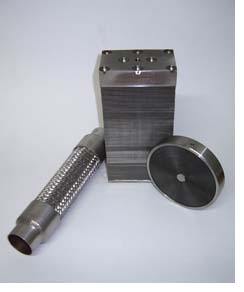
Where flammable or combustible materials are stored or handled, there can be a severe risk of an explosion or fire if handling equipment such as forklift trucks are not flameproofed.
 Flameproofing of material handling equipment is the science of reducing the risk of an explosion or fire by means of specialised principles and technologies.
Flameproofing of material handling equipment is the science of reducing the risk of an explosion or fire by means of specialised principles and technologies.
Three components are needed in order to generate an explosion or fire.
- A flammable or combustible material eg. liquid, gas or dust.
- Oxygen eg. air.
- Ignition source eg. electrical sparks, mechanical sparks, hot surface and static discharges.
Sources of ignition include flames and sparks from exhaust systems, arc and sparks from electrical equipment, hot surfaces and static build up.
Chess Flameproof, a division of ASSDA member Chess Engineering Pty Ltd, specialises in the conversion of materials handling equipment for use in hazardous areas.
Materials handling equipment such as forklift trucks, tow tractors, sweepers, scissor lifts and boom lifts ranging from 1 ton to 32 tonnes have all been designed and manufactured to remove or reduce the risk of the equipment becoming the source of ignition. Both diesel and battery electric powered forklifts can be flameproofed. Note spark ignition engines ie. LPG and petrol are not permitted in any hazardous areas.
 In addition to flameproofing, Chess Engineering manufactures custom forklift attachments, engine protection systems, speed sensors/controllers and cabins as well as custom modifications and general forklift engineering.
In addition to flameproofing, Chess Engineering manufactures custom forklift attachments, engine protection systems, speed sensors/controllers and cabins as well as custom modifications and general forklift engineering.
To overcome the possible sources of ignition, a number of protection techniques are used:
Stainless steel water cooled exhaust manifold
Extreme temperatures of the gases leaving the cylinder head of the engine can easily cause the exhaust manifold to climb in temperature to a level where it may possibly ignite surrounding hazardous area atmosphere. To overcome this problem a stainless steel water cooled exhaust manifold is fitted.
Stainless steel exhaust conditioner
An exhaust conditioner is a water tank that channels the hot exhaust gases and particles through a labyrinth thus cooling and filtering.
Depending upon the area classification, a final flame trap element may be fitted as a secondary measure. Inside the exhaust conditioner is a very corrosive environment because of the exhaust gases, water and elevated temperatures.
 For standard conditions, grade 316 stainless steel has proved to be more than adequate for this application and withstands the harsh environment providing welding and post welding procedures are correctly followed. Alternatively for extremely corrosive conditions, a duplex stainless steel has been used.
For standard conditions, grade 316 stainless steel has proved to be more than adequate for this application and withstands the harsh environment providing welding and post welding procedures are correctly followed. Alternatively for extremely corrosive conditions, a duplex stainless steel has been used.
This article featured in Australian Stainless Issue 32, Winter 2005.
Images:
Main image - Stainless steel flame arrestor or flame trap used on the engine inlet to cool and quench flames that may arise from combustion malfunction.
Top right - A Combilift with stainless steel exhaust conditioner.
Above - A stainless steel final flame trap element (centre) and (left) a corrugated stainless steel exhaust flex with braided sleeve used to absorb engine movement and vibration.
Right - Toyota forklift built to Zone 1 hazardous area.